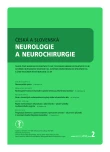The Effect of Conservative Therapy on Diplopia in Patients with Paralytic Strabismus
Authors:
L. Pražáková 1; J. Timkovič 2–4; R. Autrata 3,5; P. Rezek 1; P. Novák 6; L. Bláhová 7
Authors‘ workplace:
Oční oddělení, Oblastní nemocnice Kolín
1; LF OU, Ostrava
2; LF MU, Brno
3; Oční klinika LF OU a FN Ostrava
4; Dětská oční klinika LF MU a FN Brno
5; Katedra kybernetiky, Fakulta elektrotechnická, ČVUT v Praze
6; Neurologické oddělení, Oblastní nemocnice Kolín
7
Published in:
Cesk Slov Neurol N 2015; 78/111(2): 181-187
Category:
Original Paper
Overview
Aim:
To evaluate efficacy of pleoptic and orthoptic therapy combined with a home rehabilitation program with a support of a specifically‑ developed software in patients with ocular motility disorder and diplopia.
Methods:
Our study involved 86 adult patients with ocular motility disorder and diplopia (33 with rehabilitation – a study group, 53 without any rehabilitation – a control group). The causes of ocular motility disorders included cerebrovascular accident, craniocerebral trauma and vascular disease. A comprehensive ophthalmological and orthoptic examination were performed in all patients. The Hess‑ Lancaster screen tests were performed to objectify ocular motility disorder with diplopia. Follow‑up period ranged between 3 and 6 months in both groups.
Results:
The mean improvement of horizontal deviation in patients with the sixth cranial nerve palsy on one eye was 96.8% in the study group (p ≤ 0.01) and 28.2% in the control group (p ≤ 0.00001), and it was 73.7% in the study group (p ≤ 0.0008), 36.3% in the control group (p ≤ 0.05) in patients with the third and fourth cranial nerve palsy on one eye. The mean improvement of vertical deviation was 43.5% in the study group (p ≤ 0.002), 19.9% in the control group (p ≤ 0.04).
Conclusion:
This study demonstrates greater improvement of deviation and ocular motility deficit in adult patients who underwent the pleoptic and orthoptic therapy combined with a home rehabilitation program.
Key words:
paralytic strabismus – diplopia – conservative treatment – rehabilitation
The authors declare they have no potential conflicts of interest concerning drugs, products, or services used in the study.
The Editorial Board declares that the manuscript met the ICMJE “uniform requirements” for biomedical papers.
Sources
1. Martinez‑ Thompson JM, Diehl NN, Holmes JM, Mohney BG. Incidence, types, and lifetime risk of adult‑ onset strabismus. Ophthalmology 2014; 121(4): 877– 882. doi: 10.1016/ j.ophtha.2013.10.030.
2. Promelle V, Bremond‑ Gignac D, Milazzo S. Epidemiology of patients undergoing strabismus surgery at adult age: Retrospective study of 221 patients. Acta Ophthalmologica 2013; 91: 252.
3. Curtis TH, McClatchey M, Wheeler DT. Epidemiology of surgical strabismus in Saudi Arabia. Ophthalmic Epidemiol 2010; 17(5): 307– 314. doi: 10.3109/ 09286586.2010.508351.
4. Graham PA. Epidemiology of strabismus. Br J Ophthalmol 1974; 58(3): 224– 231.
5. Brazis PW, Lee AG. Acquired binocular horizontal diplopia. Mayo Clin Proc 1999; 74(9): 907– 916.
6. Brazis PW, Lee AG. Binocular vertical diplopia. Mayo Clin Proc 1998; 73(1): 55– 56.
7. Patel S, Holmes J, Hodge D, Burke J. Diabetes and hypertension in isolated sixth nerve palsy: a population‑based study. Ophthalmology 2005; 112(5): 760– 763.
8. Politzer T, Lenahan D. Double vision caused by neurologic disease and injury. Neurorehabilitation 2010; 27(3): 247– 254. doi: 10.3233/ NRE‑ 2010‑ 0605.
9. Tamhankar MA, Biousse V, Ying GS, Prasad S, Subramanian PS, Lee MS et al. Isolated third, fourth, and sixth cranial nerve palsies from presumed microvascular versus other causes. Ophthalmology 2013; 120(11): 2264– 2269. doi: 10.1016/ j.ophtha.2013.04.009.
10. Murchison AP, Gilbert ME, Savino PJ. Neuroimaging and acute ocular motor mononeuropathies. Arch Ophthalmol 2011; 129(3): 301– 305. doi: 10.1001/ archophthalmol.2011.25.
11. Staubach F, Lagreze WA. Oculomotor, trochlear, and abducens nerve palsies. Ophthalmologe 2007; 104(8): 733– 746.
12. Wang LP, Yu D, Qiu F, Shen J. A digital diagnosis instrument of hess screen for paralytic strabismus. 1st international conference on bioinformatics and biomedical engineering 2007; 1: 1234– 1237.
13. Kosikowski L, Czyzewski A. Computer‑based system for strabismus and amblyopia therapy. International multiconference on computer science and information Technology 2009; 1: 493– 496.
14. Dudee J. Diplopia [online]. Available from URL: http:/ / emedicine.medscape.com/ article/ 1214490– overview.
15. Borchert MS. Principles and techniques of the examination of ocular motility and alignment. In: Miller NR, Newman NJ, Biousse V (eds). Walsh and Hoyt’s clinical neuro‑ophthalmology. 6. ed. Philadelphia: Lippincott Williams 2005: 887– 905.
16. Siatkowski RM. The decompensated monofixation syndrome (an American Ophthalmological Society Thesis). Trans Am Ophthalmol Soc 2011; 109: 232– 250.
17. Flanders M, Hasan J, Al‑ Mujaini A. Partial third cranial nerve palsy: clinical characteristics and surgical management. Can J Ophthalmol 2012; 47(3): 321– 325. doi: 10.1016/ j.jcjo.2012.03.030.
18. Cabrejas L, Hurtado‑ Ceña FJ, Tejedor J. Predictive factors of surgical outcome in oculomotor nerve palsy. J AAPOS 2009; 13(5): 481– 484. doi: 10.1016/ j.jaapos.2009.08.008.
19. Yonghong J, Kanxing Z, Wei L, Xiao W, Jinghui W, Fanghua Z. Surgical management of large‑ angle incomitant strabismus in patients with oculomotor nerve palsy. J AAPOS 2008; 12(1): 49– 53.
20. Hatt SR, Leske DA, Liebermann L, Holmes JM. Successful treatment of diplopia with prism improves health‑related quality of life. Am J Ophthalmol 2014; 157(6): 1209– 1213. doi: 10.1016/ j.ajo.2014.02.033.
21. Phillips P. Treatment of diplopia. Semin Neurol 2007; 27(3): 288– 298.
22. Hatt SR, Leske DA, Holmes JM. Comparing methods of quantifying diplopia. Ophthalmology 2007; 114(12): 2316– 2322.
Labels
Paediatric neurology Neurosurgery NeurologyArticle was published in
Czech and Slovak Neurology and Neurosurgery

2015 Issue 2
- Metamizole vs. Tramadol in Postoperative Analgesia
- Memantine in Dementia Therapy – Current Findings and Possible Future Applications
- Memantine Eases Daily Life for Patients and Caregivers
- Metamizole at a Glance and in Practice – Effective Non-Opioid Analgesic for All Ages
- Advances in the Treatment of Myasthenia Gravis on the Horizon
Most read in this issue
- Aggressive Vertebral Hemangioma
- Neuromyelitis Optica
- Congenital Central Hypoventilation Syndrome (Ondine‘s Curse)
- Radiologic Assessment of Lumbar Spinal Stenosis and its Clinical Correlation
